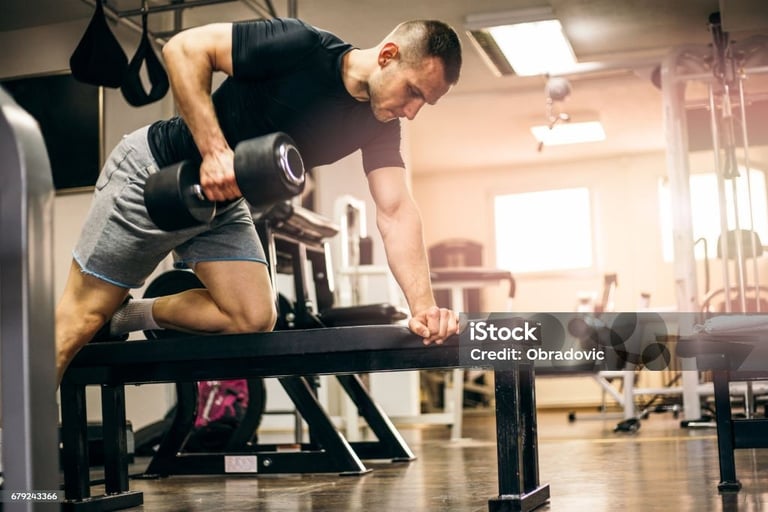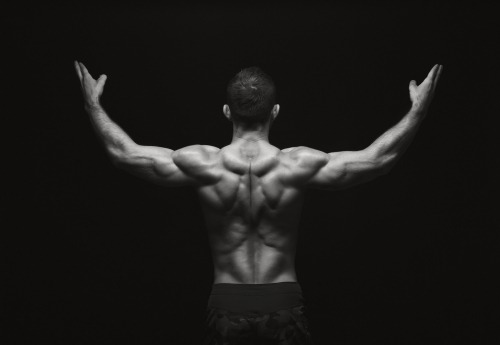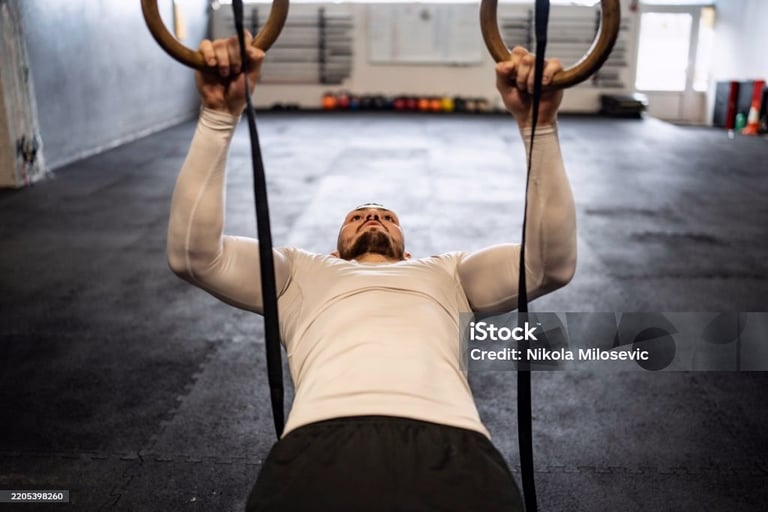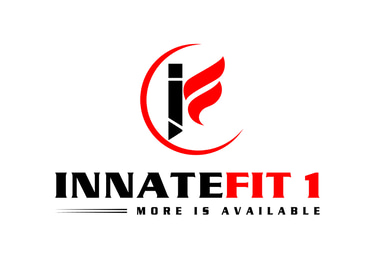Visit Innatefit1.com for exercise wear and equipment!!!
Ascending to Greatness: Unraveling the Muscle-Building Prowess of Pull-Ups and Inverted Rows
Dive deep into pull-ups vs. inverted rows to discover which reigns supreme for muscle building. Unpack mechanics, benefits, and how to maximize growth for a powerful, sculpted physique.
SELF-HELPWORKOUTSHEALTHY LIFESTYLEFITNESS TIPSSTRENGTH TRAININGHEALTHMOTIVATION
Joseph Battle
7/15/202522 min read
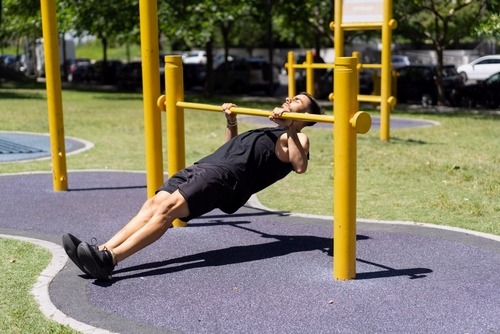

The Gravitational Tug-of-War: Defining Our Contenders
In the vast and dynamic landscape of resistance training, few exercises command as much respect and deliver as profound an impact as the pull-up and the inverted row. Both are foundational movements for developing a powerful upper body and a resilient core.
Yet, they often find themselves in an unspoken rivalry, vying for supremacy in the realm of muscle building. The pursuit of a stronger, more sculpted physique is a common thread that unites fitness enthusiasts globally, from the novice seeking fundamental strength to the seasoned athlete chasing peak performance.
Developing muscularity is not merely an aesthetic endeavor; it underpins enhanced metabolic function, improved bone density, superior athletic performance, and a reduced risk of injury in daily life.
This comprehensive exploration aims to dissect the intricacies of both pull-ups and inverted rows. We will meticulously examine their biomechanics, scrutinize their impact on strength and endurance, evaluate their capacity to promote muscle growth, and assess their practicality and accessibility across various fitness levels.
Our objective is to furnish you with the insights necessary to strategically integrate these formidable exercises into your training regimen, empowering you to make informed decisions on which exercise, or more appropriately, which combination of exercises, will reign supreme in your quest for muscle-building excellence. By the culmination of this analysis, you will possess a clearer understanding of how to leverage the unique advantages of each movement to sculpt a robust and functional physique.
The Vertical Ascent: Deconstructing the Pull-Up
The Art of Elevation: Mastering Pull-Up Biomechanics
The pull-up stands as a quintessential compound exercise, renowned for its unparalleled ability to forge upper body strength and back musculature. Conceptually, it involves suspending one's body from an overhead bar and, by engaging the back and arm muscles, pulling the body upward until the chin clears the bar.
This vertical pulling motion may seem deceptively simple in its description, but it requires significant coordination, strength, and neurological control to execute effectively. The standard overhand grip, with hands slightly wider than shoulder-width apart, typically initiates the movement. From a dead hang, the ascent begins with the depression and retraction of the scapulae, followed by the powerful contraction of the latissimus dorsi, drawing the elbows down and back.
The biceps brachii and brachialis contribute significantly to the elbow flexion, while the forearms work synergistically to maintain a secure grip. The core musculature engages isometrically throughout the movement to stabilize the torso and prevent excessive swinging.
As the body rises, the upper back muscles, including the rhomboids and various parts of the trapezius, become increasingly active, ensuring a strong finish with the chest lifted towards the bar. The descent phase is equally critical, emphasizing controlled negative resistance.
This controlled lowering, which typically takes two to three times longer than the ascent, maximizes time under tension, a factor paramount for inducing muscle hypertrophy and strength adaptations. A common mistake observed during pull-ups is the reliance on momentum, often manifested as "kipping." While kipping has its place in specific athletic contexts (e.g., CrossFit for efficiency), it diminishes the muscular tension and control necessary for pure strength and hypertrophy gains.
Another frequent error is failing to achieve a full range of motion, often cutting the movement short at the top or not reaching a complete dead hang at the bottom. This limits muscle activation and potential for development. To correct these, focus on initiating the pull with the back muscles, not just the arms, and ensure a complete lockout at the bottom with the shoulders fully extended. Also, include a deliberate pause at the top with the chin clearly above the bar.
Muscular Symphony: The Prime Movers of the Pull-Up
The pull-up is a true testament to muscular synergy, as it recruits a broad spectrum of upper-body and core muscles. The primary movers, or agonists, are undeniably the latissimus dorsi, commonly known as the "lats." These large, fan-shaped muscles of the back are responsible for adduction, extension, and internal rotation of the humerus, providing the primary force for pulling the body upwards.
Their activation is crucial for developing the characteristic V-taper of the torso. Complementing the lats are the biceps brachii, located on the front of the upper arm, which act as robust elbow flexors, assisting significantly in the upward pull. The brachialis, a deeper muscle beneath the biceps, also plays a critical role in elbow flexion.
Beyond these prominent muscles, a host of synergistic and stabilizing muscles are heavily involved. The rhomboids, located between the shoulder blades, and the lower and middle trapezius assist in scapular retraction and depression, pulling the shoulder blades down and back, which is essential for a strong and stable pull.
The posterior deltoids, located on the back of the shoulders, also contribute to the pulling motion. The forearms and grip muscles (flexor digitorum profundus, flexor digitorum superficialis, etc.) endure significant isometric tension throughout the exercise, making pull-ups an excellent builder of grip strength, which translates to improved performance in numerous other lifts.
The erector spinae, multifidus, and quadratus lumborum, which form part of the core musculature, work together to stabilize the spine and maintain a rigid torso, thereby preventing unwanted sway or arching. This comprehensive muscular engagement underscores the pull-up's efficacy as a potent compound exercise for overall upper body development.
Precision in Practice: Refining Pull-Up Technique
Achieving optimal results from pull-ups hinges on meticulous attention to form and technique. To maximize muscle activation and minimize injury risk, several key principles should guide your execution. Firstly, initiate the movement with a scapular pull; that is, depress and retract your shoulder blades before bending your elbows.
This ensures that the primary force originates from your back muscles, rather than relying solely on your arms, a common pitfall. Imagine pulling your elbows down towards your hips rather than just pulling your chin over the bar. Secondly, maintain a controlled tempo throughout both the concentric (upward) and eccentric (downward) phases of the movement.
Avoid swinging or kipping, as this diminishes the tension on the target muscles. A slow, deliberate descent is particularly effective for muscle hypertrophy, as the eccentric portion of a lift causes significant muscle damage, prompting greater repair and growth.
Thirdly, ensure a full range of motion. At the bottom, allow your arms to extend fully and your shoulders to stretch, achieving a dead hang. At the top, ensure your chin clears the bar, with your chest potentially making contact if flexibility allows. This full range of motion maximizes muscle recruitment and promotes balanced development.
Fourthly, keep your core engaged by bracing your abdominal muscles and slightly tucking your pelvis. This prevents unwanted arching of the lower back and contributes to overall body stability, making the movement more efficient and effective. Finally, experiment with different grip widths and styles once proficient with the standard pull-up.
A narrower grip (close-grip pull-ups or inverted rows vs chin-ups) places more emphasis on the biceps and lats, while a wider grip challenges the lats more broadly. Practicing strict form from the outset will lay a strong foundation for progressive overload, allowing you to add repetitions, sets, or even external weight as your strength dramatically increases.
The Horizontal Haul: Unveiling the Inverted Row
The Grounded Pull: Understanding Inverted Row Mechanics
The inverted row, often referred to as the Australian pull-up or bodyweight row, presents a horizontal pulling movement that serves as an excellent complement or alternative to the vertical pull of the pull-up. Unlike the pull-up, where the body moves vertically against gravity, the inverted row involves pulling the body horizontally towards a fixed bar, rings, or even a sturdy table.
The exerciser lies supine underneath a horizontal bar, grasping it with an overhand or underhand grip, and then pulls their chest towards the bar, maintaining a rigid body line from head to heels. The feet can be placed flat on the ground with knees bent (easier) or heels with legs straight (harder). The angle of the body relative to the floor directly dictates the difficulty: the more horizontal the body, the greater the percentage of bodyweight being lifted, thus increasing the challenge.
The movement initiates from a full arm extension, with the body in a straight line. As the exerciser pulls, the shoulder blades retract and depress, and the elbows drive down and back, bringing the chest to meet the bar. The core muscles are intensely engaged throughout to prevent the hips from sagging or arching, ensuring the body maintains its plank-like rigidity.
The controlled lowering phase, similar to pull-ups, is crucial for maximizing muscle activation and time under tension. Common mistakes include allowing the hips to sag or pike, which compromises spinal alignment and shifts tension away from the target muscles. Another error is shrugging the shoulders towards the ears, which indicates improper scapular engagement.
To correct these, focus on maintaining a tight core and glutes, imagining a straight line from head to heels. Emphasize pulling with the back muscles, initiating the movement by squeezing the shoulder blades together, rather than just bending the arms. This mindful approach ensures that the muscles worked in the inverted rows are appropriately challenged.
The Horizontal Ensemble: Muscles Activated in Inverted Rows
While sharing many commonalities with the pull-up in terms of the muscle groups worked, the inverted row often emphasizes specific muscles differently due to its horizontal pulling angle. The primary muscles engaged are the latissimus dorsi, rhomboids, and trapezius (middle and lower fibers), all of which are crucial for pulling the shoulder blades together and down.
However, the horizontal nature of the pull places a more pronounced emphasis on the posterior deltoids (rear shoulders), making it an excellent exercise for developing shoulder health and posture, especially in contrast to the more lat-dominant pull-up. The biceps brachii and brachialis are also significant contributors, flexing the elbow joint to bring the body closer to the bar.
Furthermore, the inverted row is a phenomenal exercise for strengthening the core musculature. Because the body must maintain a rigid, plank-like position against gravity, the rectus abdominis, obliques, and erector spinae are constantly engaged in an isometric hold to prevent sagging or arching. This makes it not only a back and arm exercise but also a formidable core builder.
The forearms and grip muscles work continuously to maintain hold of the bar, contributing significantly to grip strength development. The versatile nature of the inverted row, allowing for easy adjustment of difficulty by changing body angle, makes it an ideal exercise for targeting various back and arm muscles effectively across a broad spectrum of fitness levels.
The ability to vary grip (overhand, underhand, neutral) also allows for subtle shifts in muscle emphasis. For instance, an underhand grip (similar to inverted rows vs chin-ups) places more emphasis on the biceps and lower lats.
Crafting the Perfect Pull: Optimizing Inverted Row Form
To fully harness the benefits of the inverted row, precision in technique is paramount. Start by positioning your body correctly: lie supine beneath a sturdy bar or rings, grasping it with an overhand or underhand grip slightly wider than shoulder-width. Ensure your entire body, from your head to your heels (or knees if bent for an easier variation), forms a straight line.
This plank-like rigidity is non-negotiable for effective muscle targeting and injury prevention. Engage your core tightly throughout the movement; imagine bracing for a punch or pulling your belly button towards your spine. This engagement prevents hip sagging or piking, ensuring the tension remains evenly distributed across your back and arms.
Initiate the pull by retracting your shoulder blades, imagining you are squeezing a pencil between them. This pre-activation ensures your back muscles are the primary drivers of the movement. Pull your chest towards the bar, focusing on driving your elbows down and back, as if you are trying to tuck them into your back pockets.
Aim to touch your chest to the bar or get as close as possible without compromising form. The descent should be slow and controlled, resisting gravity as you return to the starting position with your arms fully extended. Avoid using momentum or allowing your body to swing. Consistent execution with impeccable form, rather than chasing high repetitions with sloppy technique, will yield superior strength gains and hypertrophy.
Regularly performing inverted rows will significantly strengthen your back and arm muscles, offering substantial benefits for both muscular development and functional fitness.
The Proving Ground: A Comparative Analysis of Difficulty
Navigating the Resistance: Factors Influencing Difficulty
The perceived and actual difficulty of pull-ups and inverted rows stems from a confluence of factors, primarily centered around leverage, bodyweight utilization, and the muscular strength-to-bodyweight ratio. For pull-ups, the entire bodyweight is lifted vertically against gravity. This makes pull-ups inherently more challenging for individuals with higher body fat percentages or less developed upper body strength relative to their mass.
The leverage is also less forgiving; even minor technique errors can lead to immediate failure. Grip strength is a significant limiting factor, as the hands must support the entire body weight. Furthermore, the range of motion in a pull-up can be pretty extensive, requiring sustained muscular effort throughout the movement.
In contrast, inverted rows allow for a much broader spectrum of difficulty adjustments. By simply changing the angle of the body relative to the floor, one can dramatically alter the percentage of body weight being lifted. A more vertical body position (e.g., standing upright and pulling towards a high bar) makes the exercise very easy.
In contrast, a more horizontal position (e.g., feet elevated on a bench, body parallel to the floor) approaches the difficulty of a pull-up. This variability makes inverted rows highly adaptable for all fitness levels.
Grip strength remains essential, but it is less of a limiting factor than in pull-ups, as the weight supported by the hands is typically lower. The ability to adjust difficulty on the fly makes inverted rows an exceptional tool for progressive overload, allowing individuals to gradually increase the challenge as their strength improves, making them an excellent alternative to pull-ups for beginners.
The Fitness Spectrum: Individual Experiences and Progressive Pathways
Individual experiences with pull-ups and inverted rows often highlight their distinct roles in a progressive training regimen. For many beginners, especially those new to strength training or carrying excess body weight, a full pull-up can seem an insurmountable challenge. The sheer force required to lift one's entire body against gravity is considerable.
In such cases, the inverted row proves to be an accessible and practical starting point. It allows individuals to build foundational pulling strength in the back, biceps, and core without the overwhelming demand of lifting their whole body vertically.
As strength improves, the angle of the inverted row can be gradually lowered, progressively increasing the load and preparing the muscles for the more demanding pull-up. This makes inverted rows an invaluable alternative to pull-ups for beginners, providing a clear pathway to achieving their first unassisted pull-up.
Conversely, for seasoned lifters who can perform multiple pull-ups, the inverted row might initially feel too easy. However, its versatility allows for continuous challenge. By elevating the feet, performing single-arm variations, or adding external resistance (e.g., weighted vests or plates on the chest), the inverted row can be made incredibly demanding, challenging even advanced athletes.
The perceived difficulty, therefore, is highly relative to an individual's current strength levels and training experience. What one person finds challenging, another might find remedial, and vice versa. Understanding this adaptability is crucial for programming effectively; both exercises offer a continuum of challenge, allowing for sustained progression regardless of one's starting point.
Bridging the Gap: The Role of Each Exercise Across Fitness Levels
Analyzing the difficulty for different fitness levels reveals the complementary nature of pull-ups and inverted rows. For absolute beginners with minimal upper body strength, wall-supported inverted rows or band-assisted inverted rows can be the initial step.
As their strength increases, they can progress to standard inverted rows with feet on the floor, gradually lowering the angle until their body is nearly horizontal.
This structured progression builds the necessary muscular endurance and strength in the lats, rhomboids, biceps, and core. These foundational inverted rows directly benefit the ability to perform a pull-up. The inverted row effectively serves as a stepping stone, preparing the body for the greater demands of vertical pulling.
Once a baseline level of strength is established through inverted rows, individuals can then transition to pull-up progressions. This might involve using resistance bands for assistance, performing negative pull-ups (concentrating solely on the controlled descent), or utilizing an assisted pull-up machine for intermediate to advanced lifters.
Pull-ups become a staple for building raw vertical pulling strength and dense muscle, especially in the lats. However, inverted rows do not lose their utility; they become valuable for increasing training volume, focusing on specific muscle groups (like the posterior deltoids or particular areas of the back), or serving as an adequate warm-up or finisher.
Their adaptability allows them to continually challenge the muscles through different angles and resistance levels, ensuring ongoing stimulus for growth and strength gains. This layered approach ensures that both exercises remain relevant and challenging, making a distinct contribution to a well-rounded strength program.
The Engine Room: Impact on Strength and Endurance
Defining the Metrics: Strength and Endurance in Training
In the context of physical fitness, "strength" generally refers to the maximum force a muscle or muscle group can exert in a single effort. This is often measured by the maximum weight lifted for one repetition (1RM) or the ability to perform a few repetitions with a heavy load.
Strength training aims to increase muscle fiber size and enhance neuromuscular efficiency, enabling greater force production. "Endurance," conversely, refers to the ability of a muscle or muscle group to perform repeated contractions against a submaximal resistance for an extended period, or to sustain an isometric contraction for a prolonged duration.
This is often measured by the number of repetitions performed to failure with a lighter load. Endurance training typically focuses on improving the efficiency of energy systems and increasing the muscle's capacity to resist fatigue. Both strength and endurance are critical components of overall fitness, contributing to daily functional tasks, athletic performance, and injury resilience.
While distinct, strength and endurance are not mutually exclusive and often overlap with each other. An exercise that builds strength can also improve muscular endurance, particularly when performed with higher repetitions, and vice versa. The key lies in the training parameters—load, volume, and rest periods—that are manipulated to emphasize one over the other.
For instance, training with heavy weights and low repetitions (e.g., 3-6 reps) primarily targets strength, while lighter weights and high repetitions (e.g., 15-20+ reps) primarily target endurance. Pull-ups and inverted rows, being bodyweight exercises, allow for various manipulations to prioritize either strength or endurance development, making them highly versatile tools in a comprehensive training program.
Synergistic Development: How Pull-Ups and Inverted Rows Build Both
Both pull-ups and inverted rows are highly effective for enhancing both strength and endurance, though they tend to emphasize different aspects based on their inherent difficulty and modifiability. Pull-ups, particularly unassisted ones, are a significant test of absolute strength. The ability to lift one's entire bodyweight requires substantial force generation from the lats, biceps, and upper back.
As individuals progress from fewer repetitions to multiple sets of pull-ups, their muscular strength undeniably increases. For endurance, performing high-repetition sets of pull-ups or incorporating them into circuit training protocols can significantly improve the muscular endurance of the back and arms. The challenge of sustaining continuous tension under a heavy load (bodyweight) fosters significant endurance adaptations, making the benefits of pull-ups extend beyond just raw strength.
Inverted rows, due to their adjustable difficulty, offer a more direct pathway to tailor training for either strength or endurance. For strength development, individuals can make inverted rows very challenging by lowering their body angle to near-horizontal, elevating their feet, or even adding external weight (e.g., a weight vest).
This increases resistance, forcing the muscles to generate more force and leading to strength gains. For endurance, inverted rows excel. By using a moderate body angle, individuals can perform a high volume of repetitions, pushing their muscles to fatigue over a prolonged period of time.
This high-repetition work is excellent for improving local muscular endurance in the back and arms, as well as for building core endurance, since the core must maintain stability throughout numerous repetitions. The versatility of both exercises allows them to be incorporated into diverse training methodologies aimed at cultivating either explosive power or prolonged muscular endurance.
The Evidence Base: Comparative Impact on Performance Metrics
While direct, highly controlled scientific studies comparing the precise impact of pull-ups versus inverted rows on strength and endurance metrics in isolation might be specific, the principles of exercise science provide clear insights into their comparative efficacy.
Pull-ups, which require lifting full bodyweight vertically, are generally considered superior for developing maximal vertical pulling strength. Research on vertical pulling movements consistently demonstrates their efficacy in building strength in the latissimus dorsi, biceps, and grip.
For individuals whose goal is to perform a greater number of unassisted pull-ups or to add weight to their pull-ups, dedicated pull-up training (including negatives and assisted variations) will yield the most direct strength improvements. The progressive overload inherent in adding reps or weight directly builds strength and power output.
Conversely, inverted rows offer a unique advantage in building muscular endurance and overall back volume, especially for those who cannot yet perform many pull-ups. Because the resistance can be easily scaled down, individuals can perform higher repetitions, accumulating more total work volume, which is critical for endurance adaptations and muscle hypertrophy.
Studies on horizontal pulling movements, like inverted rows, consistently show improvements in back strength, posture, and core stability. Furthermore, the adjustable nature of the inverted row allows for a more controlled and systematic progression, which can be invaluable for long-term strength and endurance development, especially for beginners.
While pull-ups may offer a higher peak strength stimulus, inverted rows provide a broader base for endurance and foundational strength, paving the way for eventual pull-up mastery. Their distinct angles of pull also mean they complement each other, targeting muscles with slightly different emphasis, leading to more comprehensive development.
The Sculptor's Touch: Effect on Muscle Growth
The Architects of Hypertrophy: Factors Driving Muscle Growth
Muscle growth, or hypertrophy, is a complex physiological process influenced by several key factors that must be systematically manipulated through training. Firstly, mechanical tension is paramount. This refers to the force applied to the muscle fibers.
Heavy loads and full range of motion create high mechanical tension, signaling the muscle to adapt by growing stronger and larger. Secondly, muscle damage is a significant contributor. Microscopic tears in muscle fibers, often experienced during eccentric (lowering) phases of an exercise, initiate a repair process that leads to muscle protein synthesis and growth.
Thirdly, metabolic stress plays a crucial role. The accumulation of metabolic byproducts (lactate, hydrogen ions) during high-repetition sets, often felt as the "pump," contributes to cellular swelling and a cascade of anabolic signaling pathways.
Beyond these primary factors, progressive overload is the overarching principle. For muscles to continue growing, they must be continually challenged with increasing demands over time. This can be achieved by increasing the weight, repetitions, sets, decreasing rest times, or improving exercise technique.
Adequate protein intake and sufficient rest and recovery are also essential for the muscle growth process, providing the necessary building blocks and enabling the body to repair and adapt. Understanding these principles allows for the strategic application of exercises to maximize their hypertrophic potential.
The Growth Equation: How Pull-Ups and Inverted Rows Stimulate Hypertrophy
Both pull-ups and inverted rows are highly effective at stimulating muscle growth because they inherently incorporate the key factors for hypertrophy. Pull-ups, particularly when performed with strict form and a full range of motion, generate significant mechanical tension.
Lifting one's entire bodyweight (or even adding external weight) provides a strong stimulus for the latissimus dorsi, biceps, and other back muscles. The eccentric phase of the pull-up, where the body is slowly lowered, is particularly potent for inducing muscle damage, which is a powerful trigger for hypertrophy. While challenging to perform for high repetitions, pull-ups can be incorporated into sets that lead to metabolic stress, primarily when performed to failure or in higher-volume training blocks.
The ability to add external weight to pull-ups makes them excellent for continued progressive overload, enabling a sustained growth stimulus as strength increases.
Inverted rows, on the other hand, offer an unparalleled advantage in achieving high volume and accumulating metabolic stress. Because their difficulty is easily scalable, individuals can perform numerous repetitions and sets, leading to a significant "pump" and sustained time under tension. This accumulation of volume and metabolic stress is highly conducive to hypertrophy.
Furthermore, the inverted row allows for a greater focus on specific muscle groups, such as the rear deltoids and rhomboids, often neglected in more lat-dominant exercises. While the absolute mechanical tension may be lower than that of a weighted pull-up, the sheer volume and the ability to train muscles to fatigue with consistent form make inverted rows a powerful tool for hypertrophy.
Which builds more muscle, pull-ups or inverted rows, often depends on the individual's strength level and training goals. For beginners, inverted rows may be superior for initial muscle mass accumulation due to their accessibility and ability to perform higher repetitions. For an advanced lifter, weighted pull-ups will likely provide a greater mechanical tension stimulus for continued growth.
Anabolic Narratives: Subjective Experiences and Testimonials
Subjective experiences and anecdotal evidence from countless individuals in the fitness community often corroborate the scientific principles behind muscle growth from both pull-ups and inverted rows. Many trainees report significant development in their lats, leading to a broader, more imposing back, primarily from consistent pull-up training.
The satisfaction of achieving one's first unassisted pull-up is often followed by visible changes in back thickness and width, confirming the profound benefits of pull-ups for overall back musculature. These testimonials frequently emphasize the sensation of deep muscle engagement in the back during pull-ups, resulting in a sense of "density" and increased strength.
Conversely, individuals who have incorporated high volumes of inverted rows into their routines frequently speak of improved posture, broader upper backs, and enhanced shoulder health. The inverted rows' benefits are often described as contributing to a more "balanced" upper body, particularly due to the increased activation of the upper back and rear deltoids, which can counteract the forward-rounded shoulders often seen in those who predominantly train pushing movements.
Many also highlight the feeling of a sustained "pump" in their back and arms after high repetition sets of inverted rows, a clear indicator of metabolic stress driving growth. Testimonials often suggest that while pull-ups deliver raw, powerful strength and substantial lat development, inverted rows offer a more nuanced, comprehensive approach to upper back thickness and postural improvement, contributing significantly to a well-rounded and aesthetically pleasing physique. Ultimately, both exercises contribute powerfully to the anabolic environment, each with its unique hypertrophic signature.
The Accessibility Advantage: Practicality and Equipment Considerations
Arming Your Ambition: Equipment for Vertical and Horizontal Pulls
The beauty of both pull-ups and inverted rows lies in their relatively minimal equipment requirements, making them accessible exercises for strength training. For pull-ups, the primary piece of equipment is, predictably, a pull-up bar.
These are widely available and can range from inexpensive doorframe models that install without drilling to more robust wall-mounted or ceiling-mounted bars, as well as free-standing power towers or squat racks with integrated pull-up bars.
Gymnastic rings also offer an excellent alternative, providing a greater range of motion and joint-friendly movement patterns, though they require a sturdy anchor point. The investment for a decent pull-up bar is generally modest, making it an affordable addition to any home gym setup.
Inverted rows are even more forgiving in their equipment demands. All that is required is a sturdy horizontal bar or object that can support your body weight and allow for the full range of motion. This could be a low-set pull-up bar, a Smith machine bar (set low), a sturdy table or desk edge, a set of gymnastic rings (set lower than for pull-ups), or even the robust railing of a staircase. The lower the bar, the more complex the exercise, so adjustability is key.
The adaptability of the inverted row to various household items makes it an efficient exercise for those with limited access to traditional gym equipment, solidifying its place among the most practical pull exercises that can be done without equipment. The low barrier to entry for both movements significantly democratizes strength training, allowing individuals to build substantial muscle and strength with minimal financial outlay.
Innovation in Limitation: Alternatives for Equipment-Free Pulling
For individuals without access to even a basic pull-up bar or a suitable sturdy surface for inverted rows, the challenge of performing practical pull exercises without equipment necessitates creative alternatives. While no bodyweight exercise can perfectly replicate the muscle activation and loading patterns of a standard pull-up, several movements can serve as valuable substitutes to build foundational pulling strength.
For instance, door frame rows can be performed by gripping the vertical sides of a sturdy door frame (caution: ensure it's secure) and pulling the body backward. This is a variation of the inverted row, but with a different grip and stability challenge.
Another excellent alternative is towel rows or sheet rows. These involve using a strong towel or bedsheet wrapped around a sturdy pole, banister, or even draped over a closed door (again, ensuring it's highly secure and won't dislodge). By gripping the ends of the towel/sheet, one can perform a horizontal pulling motion, similar to an inverted row, but with an added grip challenge.
For general back activation, movements like superman holds (lying prone and lifting arms and legs off the floor) and bodyweight rear delt flies (lying prone and lifting arms out to the sides, squeezing shoulder blades) can target some of the synergistic muscles involved in pulling, albeit without the same load.
While these alternatives might not offer the same progressive overload potential as a dedicated bar, they provide a valuable starting point for developing the necessary strength and body awareness, bridging the gap until more suitable equipment becomes available or as interim pull-up alternatives for beginners.
Maximizing Space and Time: Efficiency of Bodyweight Pulling
Both pull-ups and inverted rows are remarkably efficient exercises in terms of time and space requirements, making them ideal for home workouts or quick gym sessions. Neither exercise requires extensive floor space; a few square feet around a pull-up bar or a sturdy surface is generally sufficient. This contrasts sharply with exercises that require large machines or significant free-weight areas.
Their compound nature means they work multiple muscle groups simultaneously, leading to a highly effective workout in a shorter duration compared to isolating individual muscles with single-joint movements. A session combining sets of pull-ups and inverted rows can provide a comprehensive upper body and core workout in a relatively brief timeframe.
For those with busy schedules, the ability to perform these exercises at home, without commuting to a gym, further enhances their practicality. A doorframe pull-up bar can be installed in minutes and removed just as quickly, allowing for spontaneous workouts whenever time permits. Inverted rows require even less setup, often utilizing existing furniture.
This inherent efficiency and accessibility mean that consistency, a crucial factor in muscle building, is easier to maintain. Regardless of constraints on gym access or available time, pull-ups and inverted rows offer a powerful and convenient solution for building significant upper-body strength and muscle mass.
The Verdict: Uniting Vertical and Horizontal Strength
A Symphony of Strength: Recapping Our Contenders
Our journey through the mechanics, difficulty, benefits of strength and endurance, muscle growth potential, and practicality of pull-ups and inverted rows reveals two distinct yet profoundly complementary exercises. The pull-up, a formidable vertical pulling movement, stands as a benchmark of upper-body strength, particularly for the latissimus dorsi, biceps, and grip.
It demands significant relative strength and provides intense mechanical tension, making it a potent stimulus for dense muscle growth. Its inherent difficulty, especially for beginners, can be a barrier, yet its mastery unlocks a new echelon of body control and power. The benefits of pull-ups extend to overall athletic performance, postural strength, and a well-defined physique.
The inverted row, a versatile horizontal pulling movement, offers unparalleled accessibility and scalability. It excels in building foundational back and arm strength, particularly emphasizing the upper back and rear deltoids, while simultaneously fortifying the core. Its adjustable difficulty makes it an ideal starting point for beginners and a valuable tool for advanced lifters seeking high volume or specific muscle emphasis.
The benefits of inverted rows include improved posture, shoulder health, and sustained muscular endurance, providing a well-rounded approach to upper body development. Both movements engage many of the same muscles worked in pull-ups, but with nuanced differences in emphasis due to their angles of pull.
The Power of Integration: Embracing Both Exercises
The overarching conclusion is not to declare a single "supreme" exercise, but rather to champion the strategic integration of both pull-ups and inverted rows into a comprehensive workout routine. To determine which builds more muscle, pull-ups or inverted rows, the truth is that both are exceptionally effective, and their combined effect often surpasses the benefits of focusing on just one.
For beginners, the inverted row serves as an indispensable bridge, building the necessary strength and muscular endurance to progress toward unassisted pull-ups. As strength develops, incorporating both allows for a more complete and well-rounded development of the entire back and arms.
Pull-ups offer the high-tension stimulus crucial for building raw strength and lat thickness. At the same time, inverted rows provide volume and nuanced muscle activation (especially for the upper back and core) that contribute to overall back width, endurance, and postural integrity.
Think of it as a vertical and horizontal attack on your pulling musculature, ensuring no muscle fibers are left untrained. This dual approach maximizes hypertrophy, fosters balanced strength, and mitigates the risk of overuse injuries that can arise from training only in one plane of motion.
The synergistic benefits of combining vertical and horizontal pulls ensure a more robust, functional, and aesthetically developed physique.
The Journey of Adaptation: Embracing Variation and Progression
The journey of muscle building is one of continuous adaptation and strategic challenge. To optimize muscle-building results with both pull-ups and inverted rows, experiment with various variations and techniques.
For pull-ups, explore wide grips, close grips, underhand grips (inverted rows vs. chin-ups principles also apply to vertical pulling, with chin-ups emphasizing the biceps and lower lats), neutral grips, and even weighted variations as you become stronger.
For inverted rows, vary your grip, elevate your feet to increase difficulty, perform single-arm rows, or incorporate pauses at the top of the movement to maximize time under tension.
Remember the principle of progressive overload: consistently strive to increase the challenge over time. This could mean growing repetitions, sets, or reducing rest periods, or adding external resistance. Listen to your body, prioritize proper form over sheer numbers, and be consistent.
By intelligently incorporating both pull-ups and inverted rows, understanding their unique contributions, and continuously seeking ways to challenge your muscles, you will unlock unparalleled gains in strength, endurance, and muscle mass, ascending to new heights of physical prowess.
